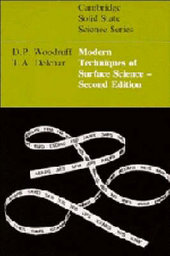
|
Modern Techniques of Surface Science
Paperback / softback
Main Details
| Title |
Modern Techniques of Surface Science
|
| Authors and Contributors |
By (author) D. P. Woodruff
|
|
By (author) T. A. Delchar
|
| Series | Cambridge Solid State Science Series |
|---|
| Physical Properties |
| Format:Paperback / softback | | Pages:608 | | Dimensions(mm): Height 229,Width 152 |
|
| ISBN/Barcode |
9780521424981
|
| Classifications | Dewey:530.417 |
|---|
| Audience | | Professional & Vocational | | Tertiary Education (US: College) | |
|---|
| Edition |
2nd Revised edition
|
| Illustrations |
7 Tables, unspecified; 9 Halftones, unspecified; 291 Line drawings, unspecified
|
|
Publishing Details |
| Publisher |
Cambridge University Press
|
| Imprint |
Cambridge University Press
|
| Publication Date |
3 March 1994 |
| Publication Country |
United Kingdom
|
Description
This is a fully revised and expanded edition of a very successful and widely used book. It describes the physical basis of all the principal, and most of the more specialised, techniques currently employed in the study of well-characterised solid surfaces. The coverage of each technique, illustrated with selected examples, is underpinned by discussion of the relevant physical principles, and the complementary aspects of the various methods are also described. Throughout, the emphasis is on understanding the concepts involved, rather than on an exhaustive review of applications. The book will be of great use to final year undergraduate and postgraduate students in physics, chemistry and materials science. It will also be valuable to established researchers in any area of surface science concerned with the acquisition and analysis of experimental data.
Reviews'Besides the dramatic development in surface science in the last few years it is, in particular, the clarity and homogeneity of the book that have led to its remarkable success ... an excellent textbook.' Zeitschrift fur Physikalische Chemie 'Their style makes this a very readable book ... the organisation and an extensive index make it easy to locate the appropriate section for the technique of interest.' Physics Today
|